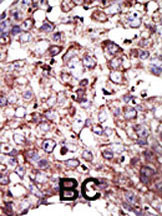FNTA Antibody (C-term)
Purified Rabbit Polyclonal Antibody (Pab)
- 产品详情
- 文献引用 : 1
- 实验流程
- 背景知识
Application
| WB, IHC-P, E |
|---|---|
| Primary Accession | P49354 |
| Other Accession | Q04631, Q61239, P29702 |
| Reactivity | Human |
| Predicted | Bovine, Mouse, Rat |
| Host | Rabbit |
| Clonality | Polyclonal |
| Isotype | Rabbit IgG |
| Calculated MW | 44409 Da |
| Antigen Region | 330-360 aa |
| Gene ID | 2339 |
|---|---|
| Other Names | Protein farnesyltransferase/geranylgeranyltransferase type-1 subunit alpha, CAAX farnesyltransferase subunit alpha, FTase-alpha, Ras proteins prenyltransferase subunit alpha, Type I protein geranyl-geranyltransferase subunit alpha, GGTase-I-alpha, FNTA |
| Target/Specificity | This FNTA antibody is generated from rabbits immunized with a KLH conjugated synthetic peptide between 330-360 amino acids from the C-terminal region of human FNTA. |
| Dilution | WB~~1:1000 IHC-P~~1:100~500 E~~Use at an assay dependent concentration. |
| Format | Purified polyclonal antibody supplied in PBS with 0.09% (W/V) sodium azide. This antibody is prepared by Saturated Ammonium Sulfate (SAS) precipitation followed by dialysis against PBS. |
| Storage | Maintain refrigerated at 2-8°C for up to 2 weeks. For long term storage store at -20°C in small aliquots to prevent freeze-thaw cycles. |
| Precautions | FNTA Antibody (C-term) is for research use only and not for use in diagnostic or therapeutic procedures. |
| Name | FNTA |
|---|---|
| Function | Essential subunit of both the farnesyltransferase and the geranylgeranyltransferase complex. Contributes to the transfer of a farnesyl or geranylgeranyl moiety from farnesyl or geranylgeranyl diphosphate to a cysteine at the fourth position from the C-terminus of several proteins having the C-terminal sequence Cys-aliphatic- aliphatic-X. May positively regulate neuromuscular junction development downstream of MUSK via its function in RAC1 prenylation and activation. |
For Research Use Only. Not For Use In Diagnostic Procedures.

Provided below are standard protocols that you may find useful for product applications.
BACKGROUND
FNTA, also known as CAAX farnesyltransferase (FTase), attaches a farnesyl group from farnesyl pyrophosphate to cysteine residues at the fourth position from the C terminus of proteins that end in the so-called CAAX box, where C is cysteine, A is usually but not always an aliphatic amino acid, and X is typically methionine or serine. This type of posttranslational modification provides a mechanism for membrane localization of proteins that lack a transmembrane domain. This enzyme has the remarkable property of farnesylating peptides as short as four residues in length that conform to the CAAX consensus sequence. FNTA is also a specific cytoplasmic interactor of the transforming growth factor-beta and activin type I receptors. It is likely to be a key component of the signaling pathway which involves p21ras, an important substrate for farnesyltransferase.
REFERENCES
Wang, T., et al., Science 271(5252):1120-1122 (1996).
Zhang, F.L., et al., J. Biol. Chem. 269(5):3175-3180 (1994).
Andres, D.A., et al., Genomics 18(1):105-112 (1993).
Omer, C.A., et al., Biochemistry 32(19):5167-5176 (1993).
终于等到您。ABCEPTA(百远生物)抗体产品。
点击下方“我要评价 ”按钮提交您的反馈信息,您的反馈和评价是我们最宝贵的财富之一,
我们将在1-3个工作日内处理您的反馈信息。
如有疑问,联系:0512-88856768 tech-china@abcepta.com.






















 癌症的基本特征包括细胞增殖、血管生成、迁移、凋亡逃避机制和细胞永生等。找到癌症发生过程中这些通路的关键标记物和对应的抗体用于检测至关重要。
癌症的基本特征包括细胞增殖、血管生成、迁移、凋亡逃避机制和细胞永生等。找到癌症发生过程中这些通路的关键标记物和对应的抗体用于检测至关重要。 为您推荐一个泛素化位点预测神器——泛素化分析工具,可以为您的蛋白的泛素化位点作出预测和评分。
为您推荐一个泛素化位点预测神器——泛素化分析工具,可以为您的蛋白的泛素化位点作出预测和评分。 细胞自噬受体图形绘图工具为你的蛋白的细胞受体结合位点作出预测和评分,识别结合到自噬通路中的蛋白是非常重要的,便于让我们理解自噬在正常生理、病理过程中的作用,如发育、细胞分化、神经退化性疾病、压力条件下、感染和癌症。
细胞自噬受体图形绘图工具为你的蛋白的细胞受体结合位点作出预测和评分,识别结合到自噬通路中的蛋白是非常重要的,便于让我们理解自噬在正常生理、病理过程中的作用,如发育、细胞分化、神经退化性疾病、压力条件下、感染和癌症。







